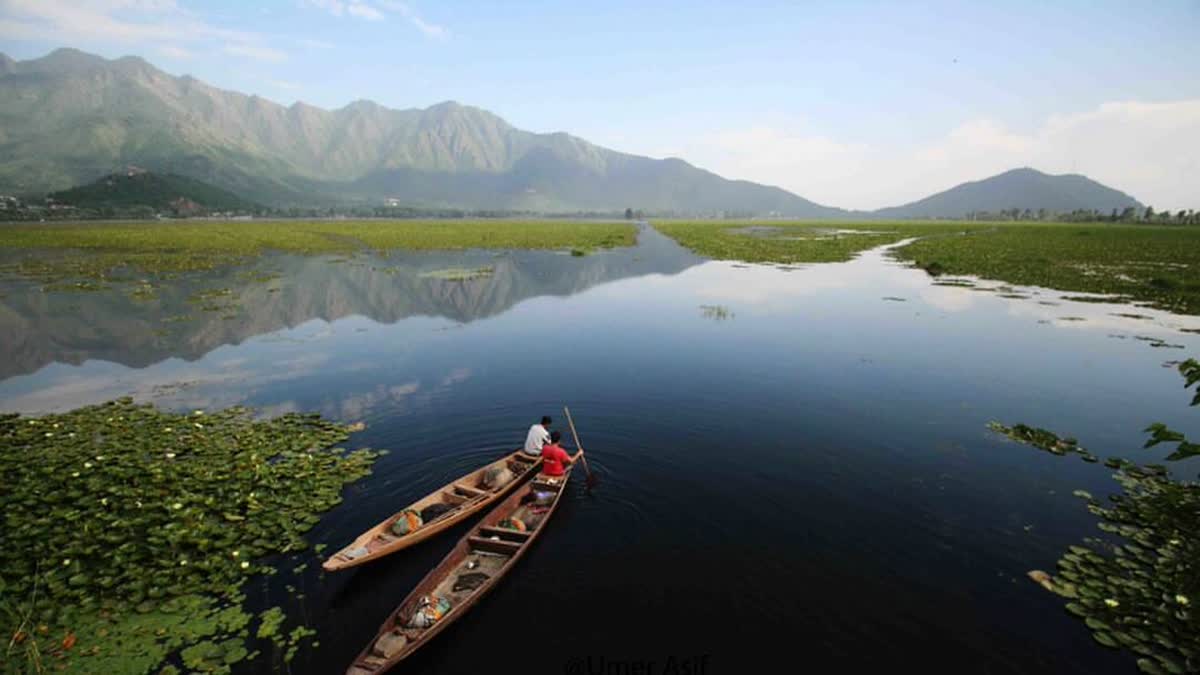Srinagar (Jammu and Kashmir): A severe heat wave is sweeping across Kashmir, pushing temperatures to unprecedented highs in several locations. Srinagar experienced its hottest July day in over two decades on Wednesday, with the mercury soaring to 35.6 degrees Celsius as per officials.
Kokernag, a renowned tourist spot, recorded its highest-ever July temperature at 33.3 degrees Celsius, surpassing the previous record of 33.0 degrees set on July 8, 1993. Qazigund, the gateway to Kashmir, reported its second hottest July day at 34.4 degrees Celsius, just shy of the all-time high of 34.5 degrees recorded on July 11, 1988.
Gulmarg, a popular ski resort, marked its hottest July day in 11 years, with temperatures reaching 25.7 degrees Celsius. This is still lower than the record of 29.4 degrees set on July 14, 1969.
In Srinagar, the temperature of 35.6 degrees Celsius was the highest since July 9, 1999, when it reached 37.0 degrees Celsius. The city's all-time highest temperature for July, 38.3 degrees Celsius, was recorded on July 10, 1946. Wednesday’s heat made Srinagar hotter than several major Indian cities, including Delhi, Aligarh, Varanasi, Indore, Bengaluru, and Kolkata.
𝙒𝙚𝙖𝙩𝙝𝙚𝙧 𝙐𝙥𝙙𝙖𝙩𝙚 𝙅&𝙆:04 July
— Meteorological Centre Srinagar (@metsrinagar) July 4, 2024
𝙁𝙤𝙧𝙚𝙘𝙖𝙨𝙩
● 4-6th July:Intermittent light to moderate rainfall at most places of J&K with heavy showers/Rainfall at few places.
●7th July:Intermittent light to moderate Rain/thunder over many places twrds early morning. pic.twitter.com/uudnKxkrNm
In the past few years, Srinagar has seen increasing July temperatures: 33.1 degrees Celsius in 2023, 34.0 degrees Celsius in 2022, and 35.0 degrees Celsius in 2021. Other parts of Kashmir also faced the heat, with Pahalgam at 30.2 degrees Celsius and Kupwara at 34.5 degrees Celsius.
Jammu, the winter capital, recorded 36.6 degrees Celsius, while Banihal reached 32.6 degrees Celsius. Batote, Katra, and Bhaderwah saw temperatures of 29.8, 31.5, and 35.6 degrees Celsius, respectively.
Experts attribute the soaring temperatures to a prolonged dry spell. "The absence of monsoon winds and rain has led to predominantly dry weather in the Kashmir region, causing temperatures to rise," said Faizan Arif Keng, an independent weather forecaster. He added that temperatures are expected to drop slightly from July 5 due to an incoming Western Disturbance, which will bring rain and thunderstorms.
The health department has issued advisories to cope with the heatwave, and the school education department has announced a 10-day summer vacation starting July 8. The intense heat has driven people indoors and increased the demand for cooling appliances.
Commuters are struggling in the city traffic, leading many to seek services for their car air conditioning systems. The meteorological department forecasts continued hot and humid weather, with potential relief from intermittent rain and thundershowers beginning Thursday.
According to the Meteorological department Srinagar, "From July 4, light to moderate rain with isolated heavy showers is expected over Jammu division. July 5-6 will likely bring moderate rainfall across most of Jammu and Kashmir, with heavy rain in some areas. July 7 may see light to moderate rain and thundershowers in many places, particularly in Jammu. From July 8-10, scattered showers are expected in Jammu, while Kashmir will see fewer rain and thundershower spells," a MET official said.
𝘼𝘿𝙑𝙄𝙎𝙊𝙍𝙔 ⚠
— Meteorological Centre Srinagar (@metsrinagar) July 4, 2024
●Flash floods, Landslides/Mudslides & shooting stones at few vulnerable places during 4-6th July.
●Few Low lying areas may experience temporary water logging conditions.
●Few places may experience moderate thunderstorm/Lightning. https://t.co/C5vF73LFpe
The department also warned of possible flash floods, landslides, mudslides, and waterlogging in low-lying areas from July 4-6.



